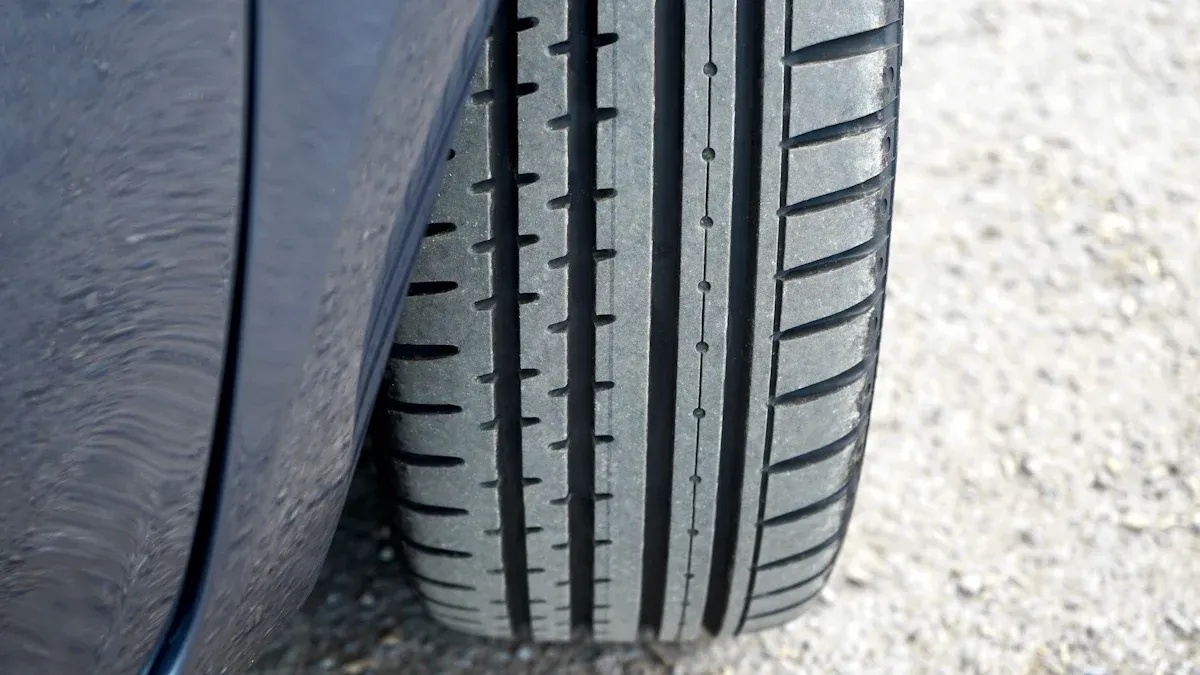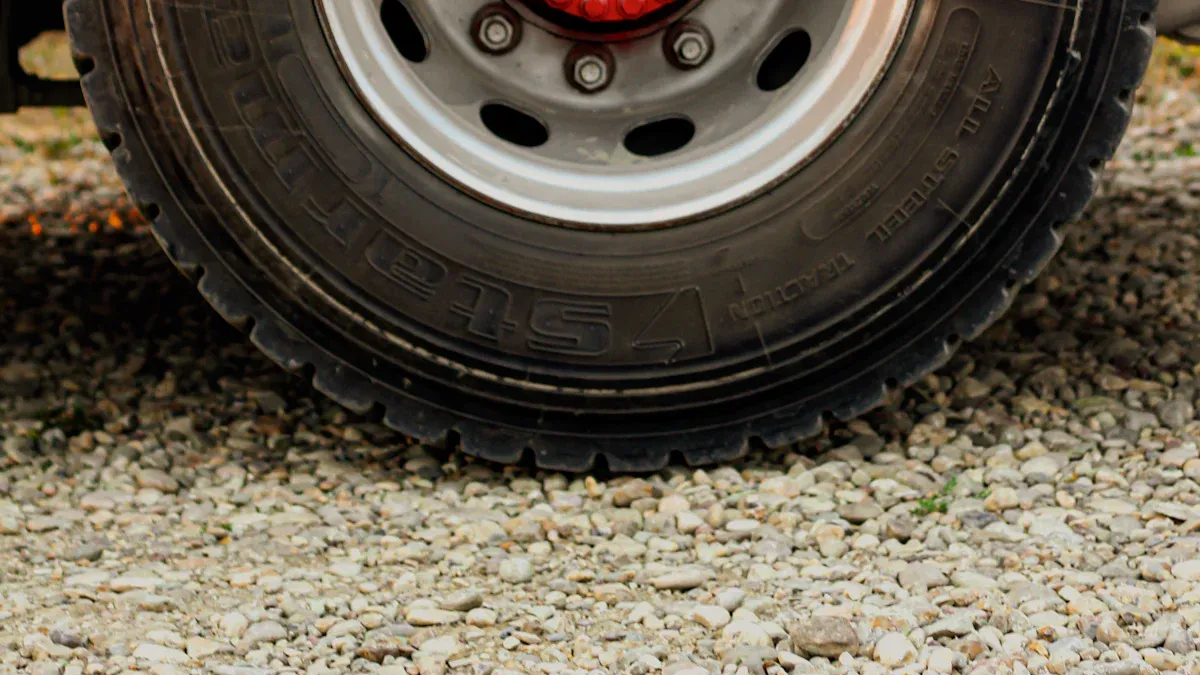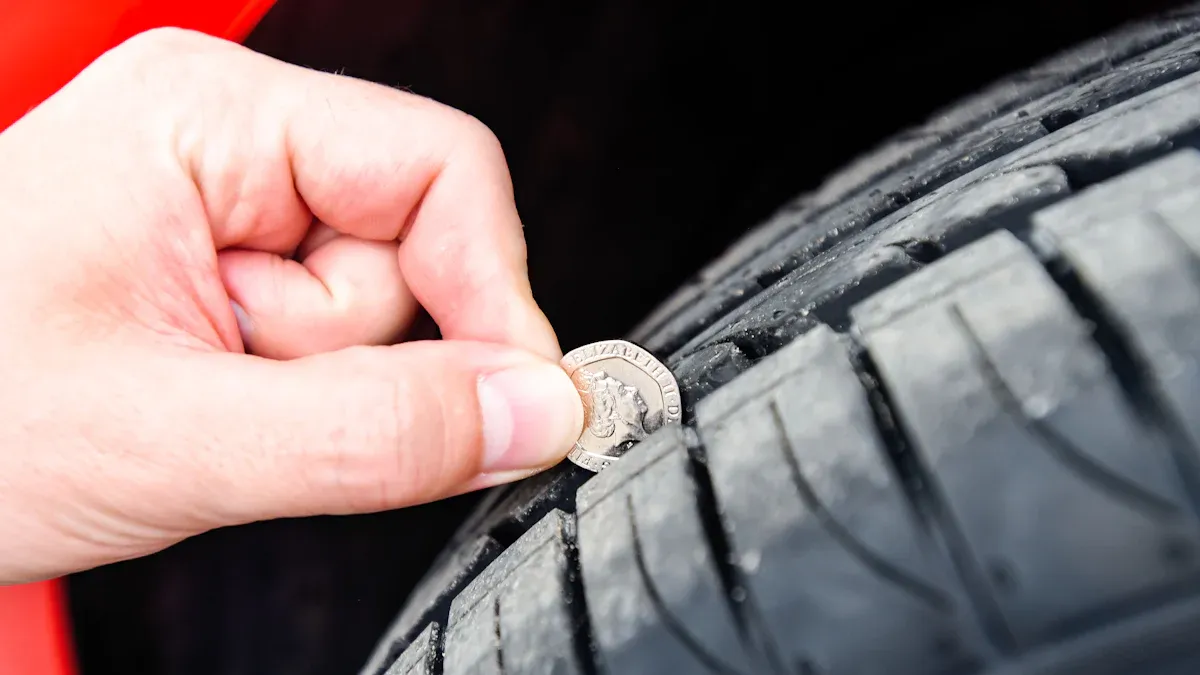
Proper tire maintenance is crucial for your safety on the road. Neglecting your tires can lead to serious consequences. For instance, improper tire care significantly increases the risk of blowouts, which can cause loss of vehicle control. Statistics show that tire-related crashes account for about 35% of vehicle defect-related accidents in the U.S., resulting in thousands of crashes and numerous fatalities each year. Regularly checking your tire tread and pressure can help reduce these risks. Knowing how do you measure tire wear at home empowers you to maintain your tires effectively and ensure a safer driving experience.
Основни изводи
Проверявайте редовно протектора на гумите си at least once a month to spot wear early and stay safe.
Use simple tests like the penny or quarter test to measure tread depth quickly at home.
Replace tires when tread depth is 2/32 inch or less to avoid dangerous driving conditions.
Inspect all parts of your tires, including tread and sidewalls, for cracks, bulges, or uneven wear.
Regular tire care improves safety, saves money, and keeps your vehicle running smoothly.
Understanding Tire Wear

Причини за износване на гумите
Tire wear occurs due to various factors. Understanding these causes helps you maintain your tires effectively. Here are some common causes of tire wear:
Tire Wear Pattern | Causes | Expert-Recommended Solutions |
|---|---|---|
Износване в центъра | Overinflation; improper wheel alignment | Regular tire pressure checks; wheel alignment inspections |
Износване по краищата | Underinflation; aggressive driving | Maintain recommended tire pressure; smooth driving habits |
Cupping | Worn shocks/struts; unbalanced tires | Replace suspension parts; balance tires |
Camber Wear | Improper camber angle; worn suspension components | Regular suspension inspections and repairs |
Driving style also plays a significant role in tire wear. Aggressive behaviors like quick acceleration and hard braking increase friction on tires. Research shows that these actions can reduce tire lifespan by up to 25%. Smooth driving habits, such as gradual acceleration and gentle braking, promote even wear and extend tire life.
Importance of Regular Checks
Regular tire checks are essential for safety and performance. Neglecting to inspect your tires can lead to serious risks. Here are some potential dangers of ignoring tire maintenance:
Increased risk of blowouts, leading to dangerous accidents.
Poor vehicle handling and reduced braking control.
Decreased traction, increasing hydroplaning risk on wet roads.
Shorter tire lifespan without regular maintenance.
To avoid these issues, you should inspect your tires at least once a month. Look for signs of wear, such as cracks or bulges. Monitor tire pressure regularly, especially in extreme conditions. Following these practices can help you maintain safe and efficient tires.
How Do You Measure Tire Wear?

Measuring tire wear at home is essential for maintaining your vehicle’s safety and performance. You can use several simple methods to assess your tire tread depth. These methods are accessible and effective for anyone, regardless of their mechanical knowledge. Here are three reliable ways to measure tire wear:
Тест с пенс
Тест с пенси is a quick and easy method to check your tire tread depth. Follow these steps to perform the test:
Grab a penny and hold it so that Lincoln’s head faces you.
Flip the penny upside down and insert it into a tread groove on your tire.
Observe how much of Lincoln’s head is visible. If you can see the top of his head, your дълбочината на протектора ви е по-малка от 2/32 инча, indicating that it’s time to replace your tires.
This method is popular because it requires no special tools and can be done in just a few minutes. However, remember that while the penny test offers a quick estimate, it may not be as precise as professional tools.
The Quarter Test
Това quarter test is another simple method that provides a slightly safer threshold for tire tread depth. Here’s how to do it:
Take a quarter and hold it with Washington’s head facing down.
Insert the quarter into the tread groove of your tire.
Check if the top of Washington’s head is visible. If it is, your tread depth is below 4/32 инча, suggesting that you should consider replacing your tires.
This test is beneficial because it helps you identify worn tires earlier than the пенс тест. It is especially important in wet or slippery conditions, where deeper tread can significantly improve traction.
Използване на измервател за дълбочина на протектора
For the most accurate measurement, consider using a измервател за дълбочина на протектора. This tool provides precise readings and can help you monitor tire wear over time. Here’s how to use it:
Extend the measuring probe fully on the tread depth gauge.
Insert the probe into the tread groove, ensuring it makes firm contact with the tread.
Read the measurement displayed on the gauge. A depth above 1.6 мм is generally acceptable.
Using a tread depth gauge allows you to take multiple measurements across the tire, helping you identify uneven wear patterns. This method is more reliable than coin-based tests and is recommended for those who want to ensure their tires are safe and effective.
Checking Multiple Areas
When assessing tire wear, checking multiple areas of each tire is crucial. Different parts of a tire can show distinct wear patterns or damage, indicating various underlying issues. For example, uneven wear on the inner or outer edges often signals alignment problems. You may notice that inner tread wear typically indicates misaligned wheels or suspension issues. This can happen due to worn shocks or struts, which affect how your tires make contact with the road.
Inner vs. Outer Tread
You should pay close attention to both the inner and outer tread of your tires. If you observe uneven wear, it may suggest that your vehicle’s alignment is off. Inner tread wear often results from negative camber angles, while outer tread wear can indicate positive camber or aggressive driving habits. Identifying these patterns early can prevent costly repairs and enhance your safety on the road.
Sidewall Inspection
Don’t overlook the sidewalls of your tires. Inspecting them can reveal serious issues like cracks, bulges, or cuts. These problems often arise from underinflation or impact damage. For instance, bulging sidewalls can indicate internal damage that significantly increases the risk of blowouts. Here are some specific problems to look for:
Cuts: Sharp objects can cause damage that leads to rapid pressure loss.
Punctures: These weaken the sidewall’s structure and often require replacement.
Bubbling and Bulging: Visible deformities can be serious blowout risks.
Cracks and Dry Rot: Aging and environmental exposure can compromise tire safety.
By regularly checking multiple areas of your tires, you can identify diverse problems early. This practice not only ensures your safety but also prolongs the life of your tires.
Signs for Tire Replacement
Recognizing when to replace your tires is crucial for your safety. Several visual indicators can signal that your tires have reached the end of their useful life. Here are some key signs to watch for:
Визуални индикатори
Reduced Tread Depth: Use the penny or quarter test to check your tread depth. If you can see the top of Lincoln’s or Washington’s head, your tread is too shallow.
Tread Wear Bars: These built-in indicators become flush with the tire tread when it reaches the legal minimum of 2/32 inch. If you see these bars, replace your tires immediately.
Uneven Tread Wear Patterns: Look for signs of uneven wear, which can indicate alignment issues or improper inflation.
Повреждане на страничната стена: Inspect for cracks, bulges, or bubbles. These signs often indicate internal damage and require immediate attention.
Abnormal Tire Vibrations: If you feel unusual vibrations while driving, this may signal internal damage or imbalance.
Ignoring these signs can lead to dangerous driving conditions, such as reduced traction and increased risk of hydroplaning. Adequate tread depth is essential for maintaining grip, especially on wet or icy roads.
Professional Assessment
You should seek a professional assessment if you notice any of the following issues:
Camber-Related Edge Wear: Bald spots on one edge of the tire suggest suspension alignment problems.
Directional Wear Patterns: These indicate caster or toe-in misalignment.
Tire Cupping: This irregular wear signals worn shock absorbers, struts, or unbalanced tires.
Slow Leaks: If you experience slow leaks from punctures or bead seal leaks, a professional can repair them effectively.
Unusual Wear Patterns: If your tires show signs of uneven wear, it’s essential to have them inspected to rule out mechanical issues.
Taking your vehicle to a professional alignment or tire specialist ensures accurate diagnosis and repair. Regular inspections and adherence to both legal and manufacturer guidelines help maintain safety and prolong tire life. Remember, your tires are your only contact with the road, so keeping them in good condition is vital for your safety.
Maintaining your tires is essential for safe driving and cost savings. Here are the main takeaways for effectively measuring tire wear at home:
New tires typically have tread depths between 10/32″ and 12/32″.
Tires are considered bald and unsafe at 2/32″ tread depth or less.
Използвайте измервател за дълбочина на протектора for precise measurement; if unavailable, use the penny test.
Regular checks help detect issues early, preventing costly repairs and enhancing safety.
By regularly inspecting your tires, you improve vehicle handling and fuel efficiency. Proactive tire maintenance not only keeps you safe but also saves you money in the long run. Remember, your tires are your only contact with the road, so take care of them!
Често задавани въпроси
How often should I check my tire wear?
You should check your tire wear at least once a month. Regular inspections help you catch issues early and maintain safe driving conditions.
Каква е минималната дълбочина на протектора за безопасно шофиране?
The minimum tread depth for safe driving is 2/32 inch. If your tires reach this depth, replace them immediately to ensure safety.
Can I rotate my tires at home?
Yes, you can rotate your tires at home if you have the right tools. Follow your vehicle’s manual for the recommended rotation pattern.
What tools do I need to measure tire wear?
Можете да използвате измервател за дълбочина на протектора, a penny, or a quarter to measure tire wear. Each method provides a quick way to assess tread depth.
What should I do if I notice uneven tire wear?
If you notice uneven tire wear, check your alignment and tire pressure. Consider visiting a professional for a thorough inspection and necessary adjustments.
Вижте също
Стъпка по стъпка ръководство за правилно измерване на дълбочината на протектора на гумите
Значението на редовните проверки на протектора за безопасност
Разбиране как функционират интелигентните сензори за дълбочина на грайфера на гума






